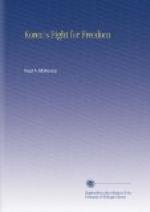One of the police visits most feared by many villagers is the periodical examinations to see if the houses are clean. If the policemen are not satisfied, they do not trouble to take the people to the station, but give them a flogging then and there. This house examination is frequently used by police in districts where they wish to punish the Christians, or to prevent their neighbours from becoming Christians. The Christian houses are visited and the Christians flogged, sometimes without even troubling to examine the houses at all. This method particularly prevails in parts of the Pyengyang province.
The police can arrest and search or detain any person, without warrant. This right of search is freely used on foreigners as well as Koreans. Any Korean taken to the police station can, in practice, be kept in custody as long as wanted, without trial, and then can be released without trial, or can be summarily punished without trial by the police.
The usual punishment is flogging—only Koreans and not Japanese or foreigners are liable to be flogged. This punishment can be given in such a way as to cripple, to confine the victim to his home for weeks, or to kill. While it is not supposed to be practiced on women, on men over sixty-five or on boys under fifteen, the police flog indiscriminately.
The Japanese Government passed, some years ago, regulations to prevent the abuse of flogging. These regulations are a dead letter. Here is the official statement:
“It was decided to retain it (flogging), but only for application to native offenders. In March, 1912, Regulations concerning Flogging and the Enforcing Detailed Regulations being promulgated, many improvements were made in the measures hitherto practiced. Women, boys under the age of fifteen and old men over the age of sixty are exempt from flogging, while the infliction of this punishment on sick convicts and on the insane is to be postponed for six months. The method of infliction was also improved so that by observing greater humanity, unnecessary pain in carrying out a flogging could be avoided, as far as possible,"[1]
[Footnote 1: Annual Report of Reforms and Progress in Chosen. Keijo (Seoul), 1914.]
So much for the official claim. Now for the facts.
In the last year for which returns are available, 1916-17, 82,121 offenders were handled by police summary judgment, that is, punished by the police on the spot, without trial. Two-thirds of these punishments (in the last year when actual flogging figures were published) were floggings.
The instrument used is two bamboos lashed together. The maximum legal sentence is ninety blows, thirty a day for three days in succession. To talk of this as “greater humanity” or “avoiding unnecessary pain” gives me nausea. Any experienced official who has had to do with such things will bear me out in the assertion that it is deliberately calculated to inflict the maximum of pain which the human frame can stand, and in the most long drawn out manner.




